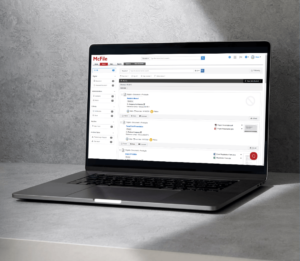Document Management Systems (DMS): Everything you need to know to organize and protect your information
In today’s fast-paced business landscape, where data and information flow continuously, having control over document organization and security has become essential for operational efficiency and risk management. Implementing a document management system (DMS) is no longer just a good-to-have; it’s critical to ensuring that vital business information is accessible, safe, and compliant with regulations.
If you’ve ever wondered how to manage documents more effectively, reduce operational costs, and still ensure fast and secure access, this comprehensive guide will walk you through everything you need to know about document management. Let’s explore what DMS is, its advantages, and how to choose the best system for your company’s unique needs.

What is Document Management?
Document management involves organizing, storing, and managing documents so they can be easily located, accessed, and shared securely. A DMS consolidates all your critical files into a single, protected location, reducing the risk of data loss and increasing productivity.
Whether it’s contracts, financial reports, client communications, or internal records, a DMS centralizes all documentation in a way that’s secure yet easily accessible. This kind of system is supported by digital tools that streamline storage and retrieval, enhancing the efficiency of handling both physical and digital documents.
Benefits of Document Management Systems for Businesses
Adopting a DMS brings tangible, transformative benefits to businesses of all sizes. Here are some of the most impactful advantages:
1. Cost Reduction
- Less Physical Storage: With digitalized documents, your organization requires less physical space, saving on storage costs.
- Operational Efficiency: Faster retrieval times mean less administrative effort, enabling your team to focus on high-value tasks.
2. Boosted Productivity
- Quick, Secure Access: Instead of hunting through file cabinets or scattered folders, employees can quickly locate documents through optimized search features.
- Process Automation: Many DMS solutions offer automated workflows, such as approval processes and document notifications, which save time and eliminate manual tasks.
3. Compliance and Security
- Data Security: Information security is paramount, especially with strict data protection regulations like GDPR in Europe. A strong DMS provides role-based access control and data encryption, reducing exposure to security breaches.
- Regulatory Compliance: Proper document organization and audit trails simplify compliance with industry standards and regulatory audits.
How to Choose the Ideal Document Management System
With so many options available, choosing the right DMS tailored to your business needs can be a challenge. Here are some critical points to guide your decision:
- User-Friendliness and Integration: The system should be intuitive so employees can easily adapt. It’s also essential that it integrates with other core tools, like CRM, ERP, and accounting software, to provide a seamless experience.
- Automation Capabilities: Look for automation features, such as approval workflows, version control, and deadline reminders. These features enhance organization and eliminate repetitive manual tasks.
- Security and Access Controls: Your DMS should offer top-notch security features, including role-based access controls and data encryption, especially for handling sensitive documents.
- Cloud Storage: Cloud-based DMS options allow access to documents anytime, anywhere, making remote work and team collaboration easier and more efficient.
- Reporting and Insights: Opt for a DMS that provides detailed usage reports and analytics. These insights enable you to monitor document usage and optimize your processes based on actual data.
Step-by-Step Guide to Implementing Document Management
Implementing a DMS successfully takes careful planning. Here’s a quick guide to ensure a smooth transition:
- Map Out Processes and Identify Needs: Assess which documents need management, the departments involved, and the issues your DMS should address.
- Select and Customize the System: Choose the system that best aligns with your needs and configure it to suit your workflows.
- Train Your Team: Make sure all employees are familiar with the system, understand its benefits, and know how to use it effectively.
- Implement and Monitor: Launch the system, monitor usage, and adjust as needed to ensure it’s optimized for your business.
Take the Next Step Toward a More Organized, Secure Business
A DMS can be a game-changer, bringing organization, security, and efficiency to your business operations. Effective document management streamlines daily processes and safeguards essential business information, whether your organization is large or small.
Ready to transform the way you manage documents? Contact us today to learn more about how our document management solution can support your business’s growth and security.
